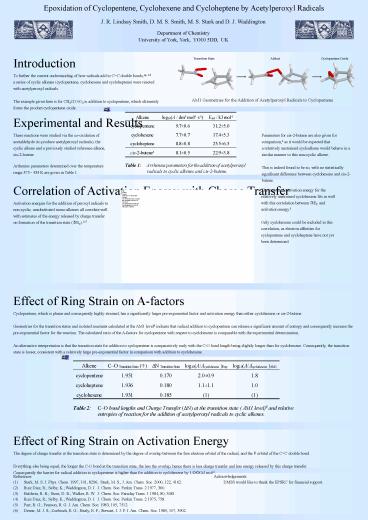Department of Chemistry - PowerPoint PPT Presentation
1 / 1
Title:
Department of Chemistry
Description:
Faraday Trans. 1 1984, 80, 3481. (4) Ruiz Diaz, R.; Selby, K. ... Perkin Trans. 2 1975, 758. (5) Parr, R. G.; Pearson, R. G. J. Am. Chem. Soc. 1983, 105, 7512. ... – PowerPoint PPT presentation
Number of Views:29
Avg rating:3.0/5.0
Title: Department of Chemistry
1
Epoxidation of Cyclopentene, Cyclohexene and
Cycloheptene by Acetylperoxyl Radicals
J. R. Lindsay Smith, D. M. S. Smith, M. S. Stark
and D. J. Waddington
Department of Chemistry University of York, York,
YO10 5DD, UK
Introduction To further the current understanding
of how radicals add to CC double bonds,eg. 1-3 a
series of cyclic alkenes (cyclopentene,
cyclohexene and cycloheptene) were reacted with
acetylperoxyl radicals. The example given here
is for CH3C(O)O2? addition to cyclopentene, which
ultimately forms the product cyclopentene oxide.
Adduct
Transition State
Cyclopentene Oxide
AM1 Geometries for the Addition of Acetylperoxyl
Radicals to Cyclopentene
Experimental and Results These reactions were
studied via the co-oxidation of acetaldehyde (to
produce acetylperoxyl radicals), the cyclic
alkene and a previously studied reference alkene,
cis-2-butene. Arrhenius parameters determined
over the temperature range 373 - 433 K are given
in Table 1.
Parameters for cis-2-butene are also given for
comparison,4 as it would be expected that a
relatively unstrained cycloalkene would behave in
a similar manner to this non-cyclic alkene. This
is indeed found to be so, with no statistically
significant difference between cyclohexene and
cis-2-butene.
Correlation of Activation Energy with Charge
Transfer Activation energies for the addition of
peroxyl radicals to non-cyclic, unsubstituted
mono-alkenes all correlate well with estimates
of the energy released by charge transfer on
formation of the transition state (?EC).2-5
The measured activation energy for the
relatively unstrained cyclohexene fits in well
with this correlation between ?EC and activation
energy.1 Only cyclohexene could be included in
this correlation, as electron affinities for
cyclopentene and cycloheptene have not yet been
determined.
Effect of Ring Strain on A-factors Cyclopentene,
which is planar and consequently highly strained,
has a significantly larger pre-exponential factor
and activation energy than either cyclohexene or
cis-2-butene. Geometries for the transition
states and isolated reactants calculated at the
AM1 level6 indicate that radical addition to
cyclopentene can release a significant amount of
entropy and consequently increase the
pre-exponential factor for the reaction. The
calculated ratio of the A-factors for
cyclopentene with respect to cyclohexene is
comparable with the experimental
determination. An alternative interpretation is
that the transition state for addition to
cyclopentene is comparatively early with the C-O
bond length being slightly longer than for
cyclohexene. Consequently, the transition state
is looser, consistent with a relatively large
pre-exponential factor in comparison with
addition to cyclohexene.
Effect of Ring Strain on Activation Energy The
degree of charge transfer at the transition state
is determined by the degree of overlap between
the free electron orbital of the radical, and the
? orbital of the CC double bond. Everything
else being equal, the longer the C-O bond at the
transition state, the less the overlap, hence
there is less charge transfer and less energy
released by this charge transfer. Consequently
the barrier for radical addition to cyclopentene
is higher than for addition to cyclohexene by
14?8 kJ mol-1.
References Acknowledgements (1)
Stark, M. S. J. Phys. Chem. 1997, 101, 8296
Stark, M. S., J. Am. Chem. Soc. 2000, 122,
4162. DMSS would like to thank the EPSRC for
financial support. (2) Ruiz Diaz, R. Selby,
K. Waddington, D. J. J. Chem. Soc. Perkin
Trans. 2 1977, 360. (3) Baldwin, R. R. Stout,
D. R. Walker, R. W. J. Chem. Soc. Faraday
Trans. 1 1984, 80, 3481. (4) Ruiz Diaz, R.
Selby, K. Waddington, D. J. J. Chem. Soc.
Perkin Trans. 2 1975, 758. (5) Parr, R. G.
Pearson, R. G. J. Am. Chem. Soc. 1983, 105,
7512. (6) Dewar, M. J. S. Zoebisch, E. G.
Healy, E. F. Stewart, J. J. P. J. Am. Chem. Soc.
1985, 107, 3902.































